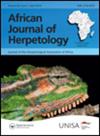Annual variation of ovarian structures of Boulengerula taitana (Loveridge 1935), a Kenyan caecilian
IF 0.9
4区 生物学
Q3 ZOOLOGY
引用次数: 5
Abstract
Abstract The Kenyan caecilian, Boulengerula taitanus inhabits a climate characterised by two distinct dry and wet seasons, and a single thermal minimum in June. It is oviparous with direct development and a remarkable dermatophagous maternal care, but the female reproductive cycle until now remains unknown. The purpose of this work was to complete the knowledge about the reproductive modes of this species, using anatomical and histological studies of the ovaries. Quantitative variations of follicle categories showed a continuous folliculogenesis. Yet, young corpora lutea were only detected between November and February during the short rain season and the short dry season, indicating ovulation occurred during these four months during the thermal maximum. Oestrogen and progesterone detection allowed determination of three reproductive periods during the year: preparation in September and October, ovulation from November until February and quiescence from March until August. So, the female reproductive cycle of B. taitanus appears to be annual and synchronised with testicular evolution. Because the ovulation was observed following the second peak of follicle production (beginning of June), temperature is supposed to be the main regulating factor of reproductive pattern in this caecilian.肯尼亚盲肠虫(Loveridge 1935)卵巢结构的年变化
肯尼亚的蛭虫,Boulengerula taitanus生活在一个气候特征为两个明显的干湿季节,和一个单一的热极小期在6月。它是卵生的,直接发育和显着的皮肤噬母护理,但女性的生殖周期直到现在仍然未知。这项工作的目的是通过对卵巢的解剖和组织学研究来完成对该物种生殖方式的了解。卵泡种类的数量变化表明卵泡发生是连续的。然而,年轻的黄体仅在11月至2月的短雨季和短旱季期间检测到,表明在这四个月的热最大值期间发生了排卵。雌激素和孕激素检测可以确定一年中的三个生殖期:9月和10月的准备期,11月至2月的排卵期和3月至8月的休眠期。因此,雌性的繁殖周期似乎是每年一次的,并且与睾丸的进化同步。由于排卵发生在卵泡产生的第二个高峰(6月初)之后,因此温度被认为是该雌蚊繁殖模式的主要调节因素。
本文章由计算机程序翻译,如有差异,请以英文原文为准。
求助全文
约1分钟内获得全文
求助全文
来源期刊

African Journal of Herpetology
ZOOLOGY-
CiteScore
3.00
自引率
6.70%
发文量
15
审稿时长
>12 weeks
期刊介绍:
African Journal of Herpetology (AJH) serves as an outlet for original research on the biology of African amphibians and reptiles. AJH is an interdisciplinary journal that publishes original articles and reviews from diverse fields and disciplines, such as conservation, phylogenetics, evolution, systematics, performance, physiology, ecology, behavioural ecology, ethology, and morphology.
The Journal publishes two issues a year. There are no page charges .
 求助内容:
求助内容: 应助结果提醒方式:
应助结果提醒方式:


